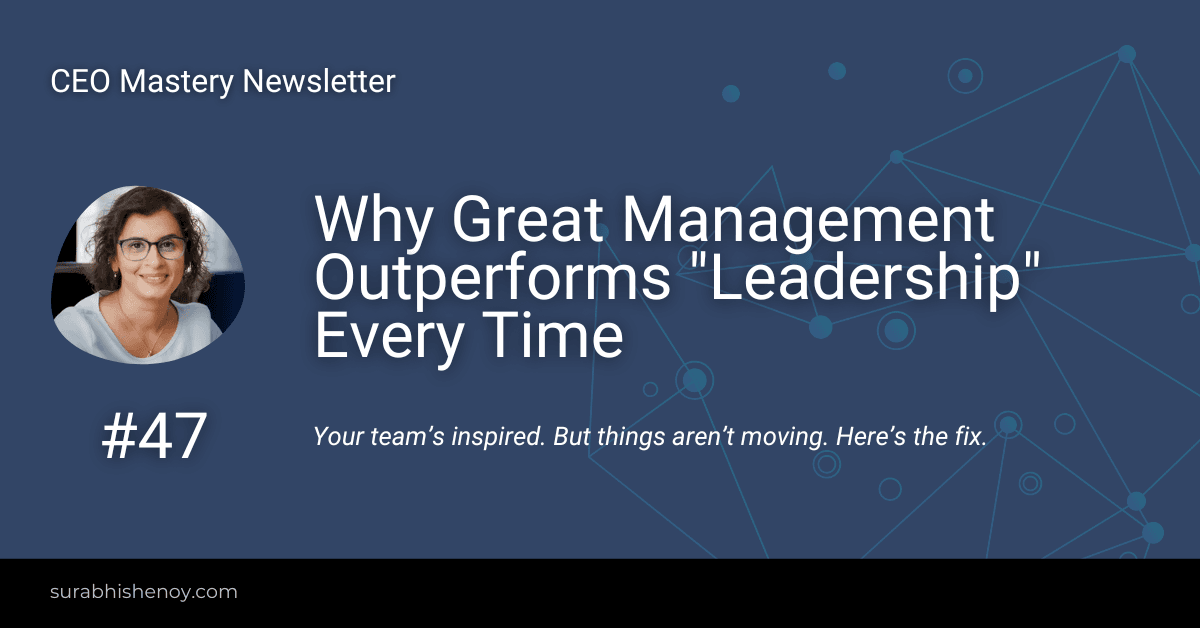Twenty-five people team felt like the promised land when you were ten.
You thought, “Once we have a real team, I can focus on strategy. I can stop firefighting.” But now you’re at 25, and somehow you’re busier than ever.
I’ve coached over 50 CEOs through the scale-up phase, and there’s one pattern I see again and again.
Somewhere between 20 and 30 people, things start to feel chaotic.
You hired that experienced VP of Sales, but three months in and you’re still closing the big deals yourself.
Your early team seems confused about priorities.
You’re in back-to-back meetings, but nothing is moving forward.
You start to wonder: Did I hire wrong? Am I bad at this? Should I just stay small?
None of those are true.
What’s actually happening is this: You’re running two businesses now, but managing only one.
Business #1: The Customer Business
This is the business you built. Product, sales, delivery, growth.
The work you love. The reason you became a founder.
Business #2: The Operations Business
This is the invisible machine. The system that allows Business #1 to function: Communication, coordination, decision-making, accountability, people development. (If you’re wondering how to build this system, read this 3-part series.)
You can’t have Business #1 at scale without Business #2.
But most founders treat Business #2 like an unnecessary evil. They avoid it, resent it, half-ass it.
That’s why everything feels broken.
Because you’re trying to scale a foundation you never built intentionally.
Why Everything Breaks at Around 25 People
At 10 people:
- Everyone knows everything
- People overhear conversations and self-coordinate
- You have a direct relationship with everyone
- Osmosis works
At 25 people:
- Information doesn’t flow naturally anymore
- People work in silos without realizing it
- You become the bottleneck —everyone needs your input
- Talented hires can’t perform because they lack context and clarity
In short: You’re trying to run a 25-person company with 10-person methods.
Why You Resist Building Business #2
Let’s be honest about why this is hard. You see Business #2 as:
- “It feels like bureaucracy.” You left corporate to avoid this.
- “Meetings are a waste.” You believe in action, not talking.
- “Good people shouldn’t need management.” They should just figure it out.
- “I don’t have time.” You’re already overwhelmed. (The classic founder catch-22.)
- “This isn’t why I became a founder.” You wanted to build product, not run HR meetings.
I get it. Every founder feels this way.
But here’s the cost: Your best people leave. Growth stalls. You become the ceiling.
The Management Tax That Pays You Back
Building Business #2 is a management tax.
You and your team will spend roughly one day per week on “the system.” Weekly meetings. 1-on-1s. Planning. Reviews.
It will feel like pure overhead, and it is.
You will resent it. Your team will complain about “too many meetings.”
But here’s the part most founders never see: The same system that works at 25 people will work at 250 people. The overhead doesn’t scale linearly. You pay this overhead but benefits compounds forever.
What "The System" Actually Looks Like
You don’t need complicated org charts or corporate bureaucracy.
You need simple, consistent operating rhythms:
- Weekly team meeting (60 min) – Share what’s happening? What’s blocked? Alignment.
- Weekly 1-on-1s (30 min each) – Give context. Coach. Catch issues early.
- Clear decision rights – Who decides what? When do you need to weigh in?
- Visible priorities – Everyone knows the top 3-5 company goals.
- Basic accountability – People report progress on their commitments.
That’s it. Not complicated. But consistent.
The Identity Shift
The hard part isn’t learning the mechanics. It’s accepting who YOU, the founder need to become next.
At 0-10 people: You’re a maker. You build, create, do.
At 20-50 people: You’re a manager. You coach, conduct, build systems.
At 50+ people: You’re a leader. You set strategy, shape culture, make decisions.
Most founders fail here. Not because they can’t learn management, but because they won’t let go of the maker identity.
The question: Can you stop being the best maker in the room and become the person who builds the system that produces great work?
This is Where Outside Perspective Helps
This is hard to see from inside, just like you can’t read the label from inside the bottle.
You need someone who’s been through the transition of 20 to 100 people. Not to tell you what to do, but to hold up the mirror. To name what you’re avoiding and why.
A coach. An advisor who’s scaled before.
Not optional at this stage, but essential.
Because the higher you scale, the harder it is to get unfiltered truth from inside the company walls.
The Choice
You have two choices:
1. Keep running Business #1 only.
Stay small. Stay involved. Cut the overwhelm. Nothing wrong with this if it’s intentional.
2. Build Business #2.
Pay the management tax. Build the system. Scale the company. Get your life back.
Both are valid.
But you can’t have scaled growth without Business #2.
The question isn’t “Should I do this?”
The question is “Am I willing to stop being just a maker?”
One Action This Week
Look at your calendar from last week.
How many hours did you spend ON the business (systems, people, strategy) vs. IN the business, doing the actual work? (If you want my help to work ON your business, check this out.)
If it’s less than 20%, you’re still trying to scale with 10-person habits.
Want to see exactly how this works for your business? Book a Clarity call here.
📚 From My Bookshelf:
Actionable insights from books that transformed me and how I built.’
Book: Grit
Brilliance gets you started. Grit keeps you in the game.
Angela Duckworth’s Grit shows why talent and IQ don’t decide who lasts, and perseverance does.
It’s a book every founder should revisit when motivation dips or growth feels slow. Because startups don’t reward intensity; they reward endurance.
I broke down ten lessons from Grit that help founders stay the course when progress stalls.
Here’s a list of all the books I have shared in this newsletter so far.




